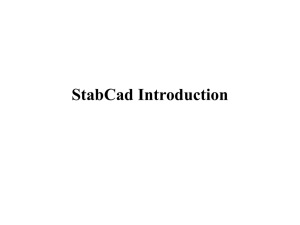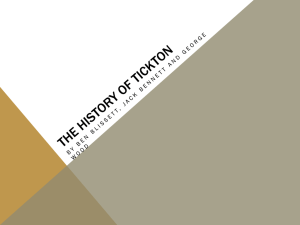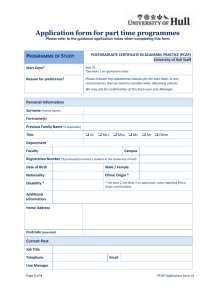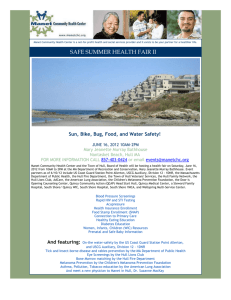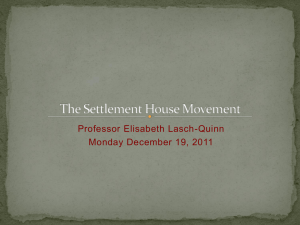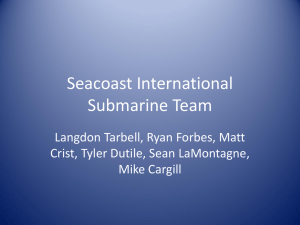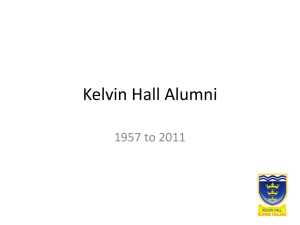Introduction - University of Hull
advertisement
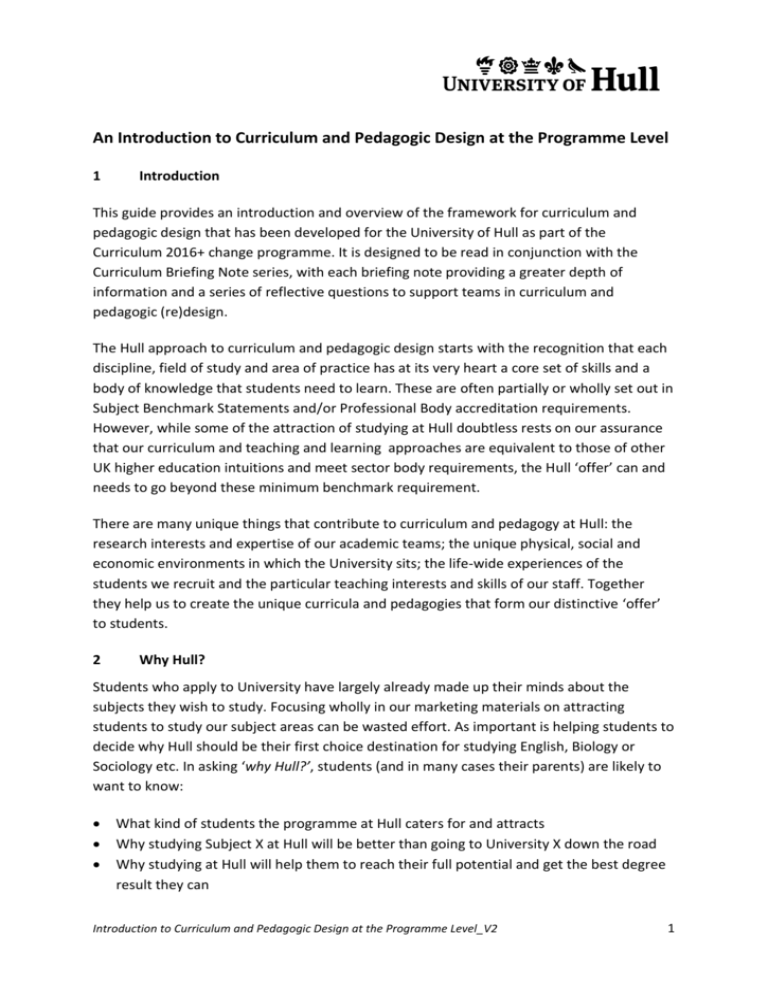
An Introduction to Curriculum and Pedagogic Design at the Programme Level 1 Introduction This guide provides an introduction and overview of the framework for curriculum and pedagogic design that has been developed for the University of Hull as part of the Curriculum 2016+ change programme. It is designed to be read in conjunction with the Curriculum Briefing Note series, with each briefing note providing a greater depth of information and a series of reflective questions to support teams in curriculum and pedagogic (re)design. The Hull approach to curriculum and pedagogic design starts with the recognition that each discipline, field of study and area of practice has at its very heart a core set of skills and a body of knowledge that students need to learn. These are often partially or wholly set out in Subject Benchmark Statements and/or Professional Body accreditation requirements. However, while some of the attraction of studying at Hull doubtless rests on our assurance that our curriculum and teaching and learning approaches are equivalent to those of other UK higher education intuitions and meet sector body requirements, the Hull ‘offer’ can and needs to go beyond these minimum benchmark requirement. There are many unique things that contribute to curriculum and pedagogy at Hull: the research interests and expertise of our academic teams; the unique physical, social and economic environments in which the University sits; the life-wide experiences of the students we recruit and the particular teaching interests and skills of our staff. Together they help us to create the unique curricula and pedagogies that form our distinctive ‘offer’ to students. 2 Why Hull? Students who apply to University have largely already made up their minds about the subjects they wish to study. Focusing wholly in our marketing materials on attracting students to study our subject areas can be wasted effort. As important is helping students to decide why Hull should be their first choice destination for studying English, Biology or Sociology etc. In asking ‘why Hull?’, students (and in many cases their parents) are likely to want to know: What kind of students the programme at Hull caters for and attracts Why studying Subject X at Hull will be better than going to University X down the road Why studying at Hull will help them to reach their full potential and get the best degree result they can Introduction to Curriculum and Pedagogic Design at the Programme Level_V2 1 3 What aspects of the teaching and learning experience that they will encounter will make them attractive to potential employers in the increasingly crowded graduate employment market What is ‘Higher’ about Higher Education? In addition it is important to note that Hull is positioning itself strategically as a research-led institution in the UK sector. The rise in the idea of the university as a place where research and teaching intersect is often associated with Wilhelm von Humboldt who established a new type of university in the early 19th Century in Berlin. Von Humboldt conceived of the University as a community of learners (teachers and their students) working together in the pursuit of knowledge. Thus, rather than the presentation of finished results to students in the form of knowledge, this approach advocated student involvement in the construction of knowledge and ideas. Indeed, teaching was viewed as being embedded in research and undertaken through research – as such teaching and research were considered to be ‘inseparable’ (Robertson, 2007: 542). The development of inclusive scholarly ‘knowledgebuilding’ learning communities (of research and teaching, staff and students) has come to the fore in recent years in the UK sector; particularly in research-intensive institutions. This approach is now recognised as one of the key ways to ensure that the benefits of combining research and teaching are understood and experienced by students and staff alike. Of course, students do not come to University knowing all of this. It is therefore important that we support students to understand what the ‘higher’ in higher education means: why we undertake research at Universities; what the connections are between our research, our teaching and their learning and what the benefits of this combined approach are. Making this explicit both to ourselves and our students will go some way to help them to answer the question ‘why Hull?’ 4 The Hull approach to Designing Curriculum and Pedagogy The Hull approach to curricular and pedagogic design rests of four key assumptions: Thinking outside of the module-box: prioritising coherent programme-level curriculum design over individual module developments; Involving a range of stakeholders: engaging students, staff (from both relevant academic areas and a range of service areas) employers and professional, statutory and regulatory bodies in programme-level curriculum design; Making the implicit explicit: developing a shared understanding amongst curriculum creators and users - teachers and learners - about how and why the curriculum and associated approaches to teaching, learning and assessment are actively designed to promote student learning; Introduction to Curriculum and Pedagogic Design at the Programme Level_V2 2 Starting from the discipline1: understanding how the epistemic2 and cultural beliefs of the discipline form an important starting point for curriculum and pedagogic design. To ensure that our research and teaching are fundamentally and explicitly connected, and to help students explicitly to understand the benefits of this approach to teaching, we are asking programme teams to work together to undertake a series of tasks as they design and plan their teaching and learning content and delivery and work towards programme validation. Each of the six tasks outlined below are likely to be undertaken in parallel and should not be viewed as discrete. Task 1: Curriculum Design: making explicit the big ideas, concepts and/or skills that lie at the heart of the programmes of study and are fundamental to the transformative educational experience that studying subject X at Hull offers (for further information see Curriculum 2016 Briefing Note A); Task 2: Pedagogic Design: making explicit the disciplinary and practice-based approaches to teaching and student learning that have been designed and adopted by the programme team at Hull and why these are a fundamental part of the ‘higher’ education we offer (for further information see Curriculum 2016 Briefing Note B); Task 3: Assessment and Feedback: making explicit why the chosen assessment methods are the most appropriate for assessing the big ideas and learning thresholds central to the programme design, and how success in achieving these outcomes is measured through the use of clear and explicit marking criteria (for further information see Curriculum 2016 Briefing Note C); Task 4: Graduate Attributes and Employability: making explicit how, within the disciplinary context, elements of our graduate attributes and associated employability skills are embedded within the curriculum and are developed through the programme’s teaching, learning and assessment approaches (for further information see Curriculum 2016 Briefing Notes D); 1 In this guidance document, discipline is used as shorthand to describe the subject areas or areas of practice that are fundamental to each degree programme. We recognise that many degree programmes do not draw on a discrete discipline per se, but reflect a field of study or area of practice which itself draws on a range of disciplinary and practice-based knowledge and understandings. 2 The term episteme is used to describe particular understandings and perceptions of what ‘knowledge’ is, how it is created and how it is best communicated. We acknowledge that these understandings and perceptions may differ across and even within each programme of study. However, it is expected that the core disciplines and areas of practice that underpin each programme of study will play a key role in formulating each area’s understanding of knowledge (its epistemic starting points). Introduction to Curriculum and Pedagogic Design at the Programme Level_V2 3 Task 5: Inclusivity and Internationalisation: actively considering ways of redesigning a programme’s curriculum and approaches to teaching, learning and assessment in order that the programmes resonate with a range of student groups and are inclusive for all (for further information see Curriculum 2016 Briefing Notes E and F); Task 6: Embedding Technology: actively considering the ways in which learning technologies can be meaningfully and authentically integrated into learning and teaching approaches to support the development of our students’ digital literacies (for further information see Curriculum 2016 Briefing Note G). 5 Some Personal Benefits The approach to programme (re)development and (re)design outlined in this guide, and other documents in the series, has been developed to support academic staff claims to have met the Standard Descriptors (at the appropriate descriptor level for the role and activities undertaken) of the UK Professional Standards Framework for Teaching and Supporting Learning in Higher Education (UKPSF). In actively taking part in this process, you will gain useful evidence to support your claim for Fellowship of the HEA and, where relevant, to support applications for promotion. References: Robertson, J. (2007) ‘Beyond the “research/teaching nexus”: exploring the complexity of academic experience’, Studies in Higher Education, 32(5), 541–56. Introduction to Curriculum and Pedagogic Design at the Programme Level_V2 4
